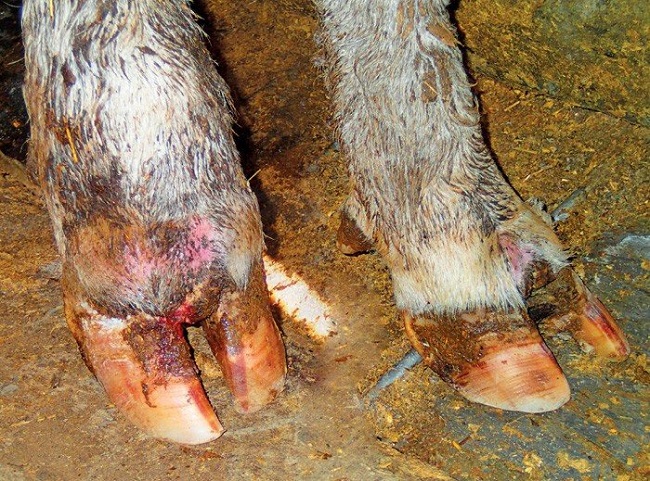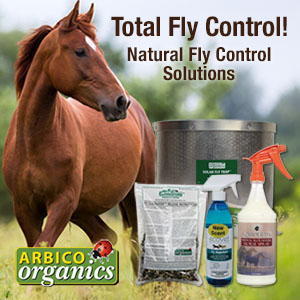
The primary infectious agent for foot rot is Fusobacterium necrophorum, which is an anaerobic bacterium. Anaerobic bacteria will only grow in the absence of oxygen. Other bacteria such as Bacteroides melaninogenicus, Staphlococcus aureus, Eschericia coli, and Actinomyces pyogenes will increase the virulence of F. necrophorum and, therefore, increase the incidence and severity of disease.
F. necrophorum can be isolated on non-diseased feet, as well as in the rumen and feces of normal cattle. Therefore, it is necessary for there to be an injury to the skin and underlying tissues between the toes for the bacteria to gain entrance and cause disease. Injury is often caused by walking on abrasive or rough surfaces, stony ground, sharp gravel, hardened mud, or standing in a wet and muddy environment for prolonged periods of time. High temperatures and humidity will also cause the skin to chap and crack, leaving it susceptible to bacterial invasion. Calves are the more susceptible to the disease than cows or bulls. Mineral deficiencies of zinc, selenium, and copper seem to increase the incidence of disease.
Treatment
The most common treatment for foot rot is a long-acting tetracycline (200 mg oxytetracycline) such as LA-200®, Biomycin 200®, Oxycure 200®, and a number of other generic products. The dose is 4.5 cc per 100 pounds of body weight given under the skin (subcutaneously [SQ]). This may be repeated in 48 to 72 hours if needed. Penicillin is sometimes used but requires daily doses and is an extra label use of this product, so a veterinarian must be consulted before using this. Nuflor® is approved for use in foot rot at 6 cc per 100 pounds of body weight. Nuflor® has been shown to be very effective in the treatment of foot rot but will be more expensive. For this reason, many producers use it for cases that do not respond to initial treatment. Excenel® is also approved in beef cows for foot rot, and only has a three-day meat withdrawal. It would be a good choice if the animal might be marketed soon.
Along with antibiotics, flossing between the toes with a clean rope or twine will help remove some of the dead tissue. Keeping the foot clean and dry is helpful. All SQ injections should be given in the neck or in front of the shoulder. If the foot does not improve within two to three days, a veterinarian should be consulted. A veterinarian can remove the infected tissue surgically, or, in severe cases that only involve one toe (or claw), the toe can be amputated. For valuable animals, a claw salvage surgery may be attempted.
Prevention
Prevention is an important aspect of this disease, and the major focus is to ensure good health of the foot. Rough areas should be smoothed or fenced off from cattle, and debris should be cleared. Sharp gravel should be replaced with smooth stones. To keep cattle from standing in wet, muddy conditions, barnyards should be scraped frequently, and measures to improve drainage should be taken.
Provided by John F. Currin, D.V.M. and W. Dee Whittier, D.V.M., Extension Veterinary Specialists, Virginia Tech.
Related Articles & Free Email Newsletter Sign Up
Proper Handling of Cattle Leads to a Healthier Herd
Proper Prepping of Dairy Cattle Leads to Better Milk Production
Proper Reproductive Culling of Dairy Cows




Comment here